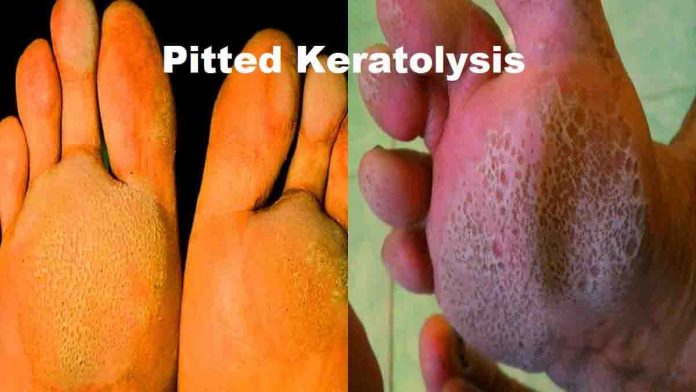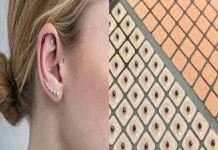Pitted Keratolysis Home Remedy
Are you tired of dealing with embarrassing foot odor caused by pitted keratolysis & finding home remedy? Don’t worry; we’ve got you covered! Pitted Keratolysis home remedy article will explore various home remedies that can help you effectively manage and treat pitted keratolysis. Say goodbye to foul-smelling feet and regain confidence with these simple yet powerful solutions.
1. Pitted Keratolysis
Pitted keratolysis is a common foot condition characterized by the formation of small pits or depressions on the soles of the feet. These pits are caused by the overgrowth of bacteria, specifically Corynebacterium species, in the moist and warm environment of the feet. The bacteria thrive on sweat, heat, and dead skin cells, producing foul-smelling sulfur compounds.
2. Causes and Symptoms of Pitted Keratolysis
Pitted keratolysis is primarily caused by excessive sweating, poor foot hygiene, and tight, non-breathable footwear. People who sweat excessively, such as athletes or individuals living in humid climates, are more prone to developing this condition.
The common symptoms of pitted keratolysis include:
- Foul odor (resembling rotten eggs) coming from the feet
- White, gray, or brownish pits on the soles
- Scaling or peeling skin
- Itching or discomfort
3. Importance of Proper Foot Hygiene
Maintaining good foot hygiene is essential in preventing and managing pitted keratolysis.
Follow these simple tips to keep your feet clean and healthy:
- Make it a habit to cleanse your feet daily using lukewarm water and a gentle soap.
- Ensure thorough drying of your feet, paying particular attention to the spaces between your toes, as excess moisture can foster the growth of bacteria.
- Use a clean towel to dry your feet before wearing socks and shoes.
- To maintain foot hygiene and prevent bacterial proliferation, it is recommended to alternate your footwear and not consistently wear the same pair of shoes. To allow them to dry and reduce bacterial buildup.
- Wear moisture-wicking socks made of natural fibers to keep your feet dry and ventilated.
4. Natural Remedies for Pitted Keratolysis
While there are over-the-counter and prescription treatments available for pitted keratolysis, you may also consider trying these effective home remedies:
4.1. Tea Tree Plant Oil
Tea tree plant oil has a robust antibacterial specialty that can help eliminate the bacteria causing pitted keratolysis. Mix some tea tree plant oil drops in a carrier like a coconut oil and apply them to the affected areas. To get the best results try twice a day.
4.2. Vinegar Soaks
Vinegar has acidic properties that create an unfavorable environment for bacteria. Prepare a foot soak by adding one part vinegar to two parts warm water. Each day, spend 15 to 20 minutes soaking your feet in this solution. Pat your feet dry afterward.
4.3. Baking Soda Paste
Baking soda possesses remarkable moisture-absorbing properties, effectively neutralizing unpleasant odors. You can create a simple paste by combining baking soda with water and applying it generously to your feet. Before rinsing it off with water, let it on for 10 to 15 minutes. Repeat this remedy twice a day.
4.4. Epsom Salt Foot Baths
Epsom salt can help reduce foot odor and control bacterial growth. Immerse your feet in a warm water bath infused with a half cup of Epsom salt, allowing them to soak for 15 to 20 minutes. Dry your feet thoroughly afterward.
5. Footwear and Socks: Choosing the Right Ones
The type of footwear and socks you choose can significantly impact pitted keratolysis. Opt for breathable shoes made of natural leather or canvas to allow proper air circulation. Avoid wearing moist-attracting, tight-fitting, synthetic shoes. Also, moisture-wicking cotton or bamboo socks can help keep your feet dry and minimize bacterial growth.
6. Prevention Tips for Pitted Keratolysis
Taking proactive measures is crucial in preventing pitted keratolysis. Keep the following suggestions in mind to lower your risk of developing the condition:
- Practice good foot hygiene, as mentioned earlier.
- Rotate your shoes so they may fully dry out in between wears.
- Use foot powders or antiperspirants to help control excessive sweating.
- Avoid walking barefoot in public places, especially where the floor is wet.
- Choose open-toed shoes or sandals when weather permits to increase ventilation.
7. When to Seek Medical Help
While home remedies can be effective in most cases of pitted keratolysis, it’s essential to consult a healthcare professional if:
- The condition persists or worsens despite home treatments.
- You experience severe pain, inflammation, or signs of infection.
- You have underlying medical conditions that may complicate the treatment.
Conclusion
Pitted keratolysis can be unpleasant and embarrassing, but you can effectively manage it with the right approach. You can significantly reduce foot odor and bacterial growth by following proper foot hygiene practices, using natural remedies, and choosing appropriate footwear. Remember to consult a healthcare professional if needed for personalized advice.
FAQs (Frequently Asked Questions)
1. Can pit keratolysis be cured completely?
While pitted keratolysis can be effectively managed, it may sometimes recur. Consistent foot hygiene and preventive measures can help minimize the chances of recurrence.
2. Are there any specific dietary changes to help with pitted keratolysis?
There are no specific dietary changes known to treat pitted keratolysis directly. However, maintaining a balanced diet and staying hydrated can improve overall skin health.
3. Can pit keratolysis affect other parts of the body?
Pitted keratolysis primarily affects the soles of the feet due to the unique conditions present in that area. It is uncommon for it to spread to other body parts.
4. Can over-the-counter antifungal creams treat pitted keratolysis?
Bacteria, not fungi, primarily cause pitted keratolysis. While antifungal creams may have some effect, they are not specifically designed for treating this condition. Consult a healthcare professional for appropriate treatment options.
5. Is pitted keratolysis contagious?
No, pitted keratolysis is not contagious. It is caused by bacteria on the skin and is aggravated by specific environmental factors.
Pharmacist. Nahid Chowdhury
B.Pharm (Bachelor In Pharmacy)
Follow Fashion Food Health-
Facebook Group Link: https://www.facebook.com/groups/fashionfoodhealth
Facebook Page Link: https://www.facebook.com/fashionfoodhealth
INSTAGRAM LINK: https://www.instagram.com/fashionfoodhealth
Twitter Link: https://twitter.com/FashionFoodHeal
LinkedIn Link: https://www.linkedin.com/company/fashionfood-health

















